(INTRODUCTION)英文科技论文写作的语言技巧
introduction 写作方法
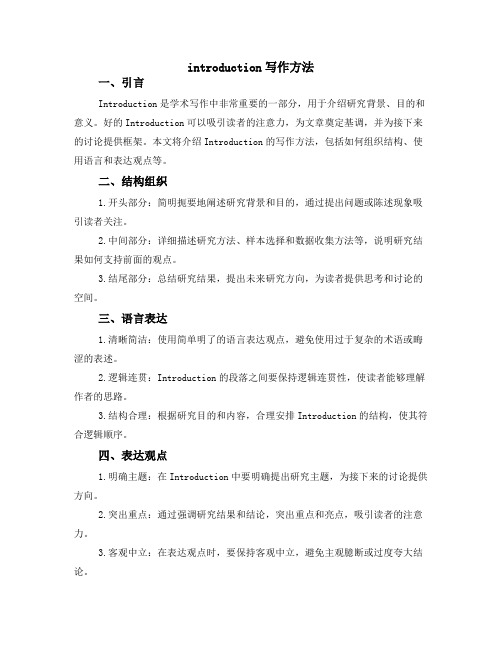
introduction写作方法一、引言Introduction是学术写作中非常重要的一部分,用于介绍研究背景、目的和意义。
好的Introduction可以吸引读者的注意力,为文章奠定基调,并为接下来的讨论提供框架。
本文将介绍Introduction的写作方法,包括如何组织结构、使用语言和表达观点等。
二、结构组织1.开头部分:简明扼要地阐述研究背景和目的,通过提出问题或陈述现象吸引读者关注。
2.中间部分:详细描述研究方法、样本选择和数据收集方法等,说明研究结果如何支持前面的观点。
3.结尾部分:总结研究结果,提出未来研究方向,为读者提供思考和讨论的空间。
三、语言表达1.清晰简洁:使用简单明了的语言表达观点,避免使用过于复杂的术语或晦涩的表述。
2.逻辑连贯:Introduction的段落之间要保持逻辑连贯性,使读者能够理解作者的思路。
3.结构合理:根据研究目的和内容,合理安排Introduction的结构,使其符合逻辑顺序。
四、表达观点1.明确主题:在Introduction中要明确提出研究主题,为接下来的讨论提供方向。
2.突出重点:通过强调研究结果和结论,突出重点和亮点,吸引读者的注意力。
3.客观中立:在表达观点时,要保持客观中立,避免主观臆断或过度夸大结论。
五、示例分析以下是一个Introduction的示例分析:1.开头部分:通过描述一种普遍存在的社会现象,引出研究主题。
2.中间部分:介绍研究方法、样本选择和数据收集方法等,说明研究结果如何支持前面的观点。
同时,通过与其他类似研究的比较,突出本研究的创新点和贡献。
3.结尾部分:总结研究结果,提出未来研究方向,并引导读者思考相关问题。
六、总结好的Introduction是学术文章成功的一半,它能够吸引读者的注意力,为文章奠定基调,并为接下来的讨论提供框架。
通过组织结构、使用语言和表达观点等方面的技巧,可以提高Introduction的写作质量。
希望本文的介绍对大家有所帮助。
SCI论文引言部分Introduction的写作
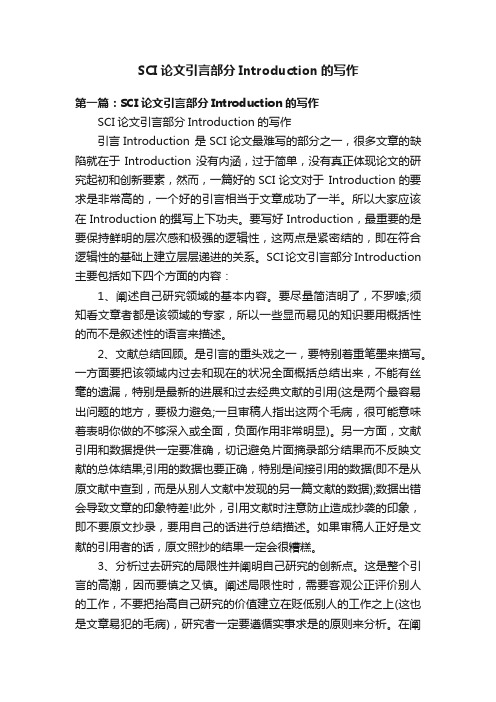
SCI论文引言部分Introduction的写作第一篇:SCI论文引言部分Introduction的写作SCI论文引言部分Introduction的写作引言Introduction 是SCI论文最难写的部分之一,很多文章的缺陷就在于Introduction没有内涵,过于简单,没有真正体现论文的研究起初和创新要素,然而,一篇好的SCI论文对于Introduction的要求是非常高的,一个好的引言相当于文章成功了一半。
所以大家应该在 Introduction的撰写上下功夫。
要写好 Introduction,最重要的是要保持鲜明的层次感和极强的逻辑性,这两点是紧密结的,即在符合逻辑性的基础上建立层层递进的关系。
SCI论文引言部分Introduction 主要包括如下四个方面的内容:1、阐述自己研究领域的基本内容。
要尽量简洁明了,不罗嗦;须知看文章者都是该领域的专家,所以一些显而易见的知识要用概括性的而不是叙述性的语言来描述。
2、文献总结回顾。
是引言的重头戏之一,要特别着重笔墨来描写。
一方面要把该领域内过去和现在的状况全面概括总结出来,不能有丝毫的遗漏,特别是最新的进展和过去经典文献的引用(这是两个最容易出问题的地方,要极力避免;一旦审稿人指出这两个毛病,很可能意味着表明你做的不够深入或全面,负面作用非常明显)。
另一方面,文献引用和数据提供一定要准确,切记避免片面摘录部分结果而不反映文献的总体结果;引用的数据也要正确,特别是间接引用的数据(即不是从原文献中查到,而是从别人文献中发现的另一篇文献的数据);数据出错会导致文章的印象特差!此外,引用文献时注意防止造成抄袭的印象,即不要原文抄录,要用自己的话进行总结描述。
如果审稿人正好是文献的引用者的话,原文照抄的结果一定会很糟糕。
3、分析过去研究的局限性并阐明自己研究的创新点。
这是整个引言的高潮,因而要慎之又慎。
阐述局限性时,需要客观公正评价别人的工作,不要把抬高自己研究的价值建立在贬低别人的工作之上(这也是文章易犯的毛病),研究者一定要遵循实事求是的原则来分析。
英文学术论文Introduction部分的写作方法
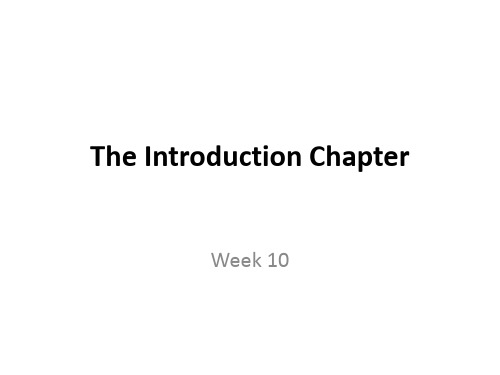
Sub-moves 1) Indicate a gap 2) Identify a problem 3) Extend previous knowledge
Moves 3 Occupy the niche
Note: 1) the word “outline” means that the content in that sub-move is very brief, no details 2) RQs are not necessary sometimes
Sub-moves 1) Outline aim, purpose 2) Specify RQs 3) Outline the theoretical perspectives 4) Describe methodology & design 5) Indicate scope/delimitation 6) explain contribution and vzation of the thesis
But in the introduction chapter of the dissertation, we usually use the following subtitles, altogether three, namely: 1) Background of the study (corresponding with Moves 1 and 2) 2) Aim and significance of the study (corresponding with Move 3.1---3.6) 3) Organization of the dissertation (corresponding with Move 3.7)
英文科技学术论文Introduction写法
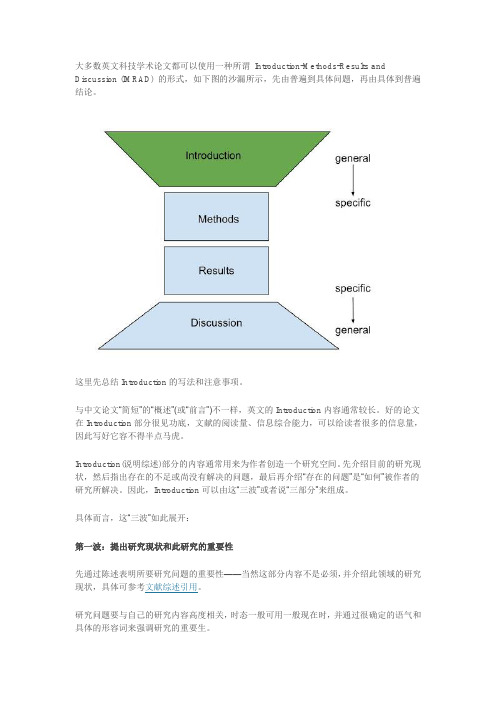
大多数英文科技学术论文都可以使用一种所谓Introduction-Methods-Results and Discussion (IMRAD) 的形式,如下图的沙漏所示,先由普遍到具体问题,再由具体到普遍结论。
这里先总结Introduction的写法和注意事项。
与中文论文“简短”的“概述”(或“前言”)不一样,英文的Introduction内容通常较长。
好的论文在Introduction部分很见功底,文献的阅读量、信息综合能力,可以给读者很多的信息量,因此写好它容不得半点马虎。
Introduction(说明综述)部分的内容通常用来为作者创造一个研究空间。
先介绍目前的研究现状,然后指出存在的不足或尚没有解决的问题,最后再介绍“存在的问题”是“如何”被作者的研究所解决。
因此,Introduction可以由这“三波”或者说“三部分”来组成。
具体而言,这“三波”如此展开:第一波:提出研究现状和此研究的重要性先通过陈述表明所要研究问题的重要性——当然这部分内容不是必须,并介绍此领域的研究现状,具体可参考文献综述引用。
研究问题要与自己的研究内容高度相关,时态一般可用一般现在时,并通过很确定的语气和具体的形容词来强调研究的重要生。
The flow of foams is seen in many process, and its use in major industries means that an understanding of foam rheology is of paramount importance.第二波:强调有必要解决存在的问题指出该研究目前存在的问题,可以通过提问的方式或者通过某种方式扩展此领域已有知识和结论。
这一波非常重要,只有指出存在的问题或尚待解决的问题,才能突显出自己的研究价值。
在这一部分的写作时,一般通过转折词来表示过渡,并在指出问题时使用负面的词汇。
… ; however, the relationship between emergence and soil temperature has not been investigated previously…In contrast to the extensive literature describing ….., little attention has been paid to…第三波:介绍作者自己的研究内容介绍作者的研究目的和大致的研究内容。
introduction的写作方法
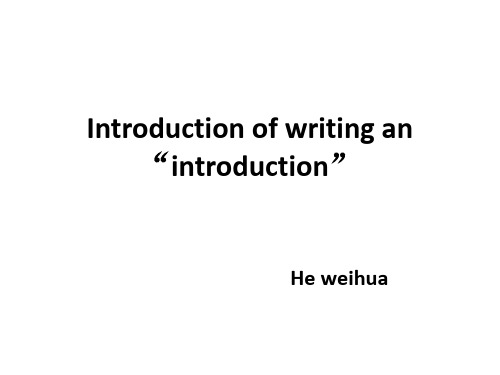
各个Move的写作要点
Move one 关键点: 热点,难点,急需 时态一般为现在完成时 Move two 关键点: 引用 时态运用 涉及到某项具体研究—过去式 涉及到研究的问题和领域—现在完成时 陈述现在的认识(当前成果)—现在时 Move three 关键点:否定的起始 指出前人研究的不足、不尽之处。 比如对于……,我们的认识还十分有限; 然而对于……,已报道的数据十分有限等。 Move four 关键点: 研究目的和意义 填补空白,完成任务,解决问题
Move one 说明研究领域 I.指明中心
1.兴趣 2.重要性 3.重要论题 4.标准程序(方法、工艺)
II.陈述现有知识 III.描述重要特征 Move two 总结前人研究 Move three 本研究的必要性 I. 指出差距 II.提出问题(任务) III. 延伸认识 Move four 介绍本研究 I. 研究用途(效果) II. 描述与介绍 introduction至少包括前三个部分 By John swales
以研究者为受众的文章introduction
这类文章的introduction对问题的阐述方式有 详有略。
对于一些共识性的假说、方法和知识,往 往不会详加阐述。
但是会包括一些技术细节,和在这一问题 上对前人的工作做一个总结。 在此基础上,作者对前人理论和方法做出 评述,或者指出不足。
Article introduction 的结构
OVER
Introduction of writing an “introduction”
He weihua
The beginning is half of the whole
—好的开始是成功的一半
“Introduction”是论文写作中非常棘手 的部分
科研方法纯干货!SCI论文中Introduction的不同部分不会写?我为你总结201个句式
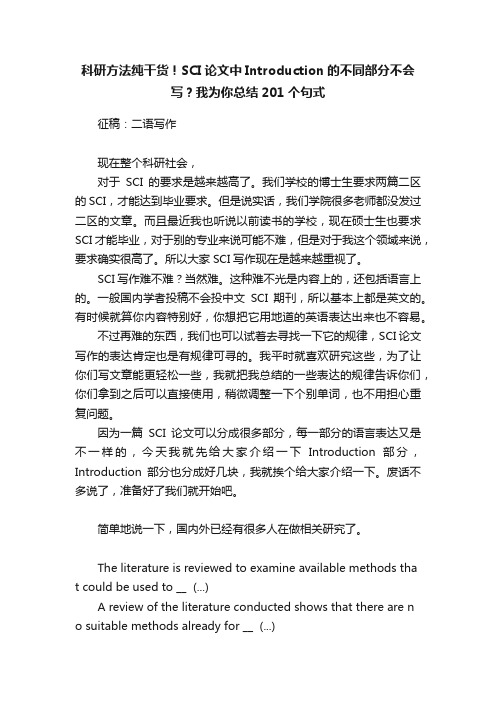
科研方法纯干货!SCI论文中Introduction的不同部分不会写?我为你总结201个句式征稿:二语写作现在整个科研社会,对于SCI的要求是越来越高了。
我们学校的博士生要求两篇二区的SCI,才能达到毕业要求。
但是说实话,我们学院很多老师都没发过二区的文章。
而且最近我也听说以前读书的学校,现在硕士生也要求SCI才能毕业,对于别的专业来说可能不难,但是对于我这个领域来说,要求确实很高了。
所以大家SCI写作现在是越来越重视了。
SCI写作难不难?当然难。
这种难不光是内容上的,还包括语言上的。
一般国内学者投稿不会投中文SCI期刊,所以基本上都是英文的。
有时候就算你内容特别好,你想把它用地道的英语表达出来也不容易。
不过再难的东西,我们也可以试着去寻找一下它的规律,SCI论文写作的表达肯定也是有规律可寻的。
我平时就喜欢研究这些,为了让你们写文章能更轻松一些,我就把我总结的一些表达的规律告诉你们,你们拿到之后可以直接使用,稍微调整一下个别单词,也不用担心重复问题。
因为一篇SCI论文可以分成很多部分,每一部分的语言表达又是不一样的,今天我就先给大家介绍一下Introduction部分,Introduction部分也分成好几块,我就挨个给大家介绍一下。
废话不多说了,准备好了我们就开始吧。
简单地说一下,国内外已经有很多人在做相关研究了。
The literature is reviewed to examine available methods that could be used to __ (...)A review of the literature conducted shows that there are no suitable methods already for __ (...)The literature was reviewed for possible methods to __ (...) An up-to-date overview of methods used for __ is presented. (...) It is important to have some awareness of current issues hig hlighted in the literature. (...)This section outlines the existing methods available in the literature for __ (...)This section discusses the literature in the field. (...)The literature review pays special attention to the class of m ethods central to our research. (...)Different solutions available in the literature to solve this pr oblem have been reviewed. (...)These citations are related to the work presented in this the sis. (...)The methods in the literature that are the most immediately relevant are reviewed. (. ..)An overview of the previous and current attempts to develo p this method is given. (...)A good overview of the research in this area is provided her e. (...)The literature review describes the previous and current atte mpts to address this issue. (...)The review provides details of the strengths and weaknesses of existing methods in the literature. (...)A review of the current state-of-the-art in the field is given. (...)A considerable amount of review of previous work in the su bject area is given below. (...)The aim of this review is to compare state-of-the-art techniques. (...)Some of the essential or seminal developments in this area are reviewed. (...)This section reviews some of the most pertinent papers on _ _ (...)The major areas of research in this area are explained. (...)This has been of interest for a considerable period, ranging from the early __ (...)There exists a very extensive literature on the topic of __ (...) In the literature, these have been extensively investigated in an attempt to __ (...)There is also a large body of work in this area considering __ (...)This is widely reported and extensively explored in the litera ture by __ (...)These have been important topics of study in the literature f or many years. (...)This has been studied by several authors in the literature. (...) Within the literature,there has been much research surrounding concepts of __ (...) There is a body of research that has focused extensively on __ (...)There are a broad interest and literature base for __ (...)Over the last x years, much research has examined __ (...)Research in this field is dominated by providing solutions to this problem. (...)This problem has attracted considerable attention in the lite rature. (...)An enormous amount of work has been carried out in this area. (...)With respect to this specific subject, there has also been sig nificant work. (...)These issues are well covered in the literature related to this subject. (...)There is a large amount of literature on this research. (...)There has been a lot of work on the __ (...)The literature on this topic is plentiful and easy to find. (...) There arefew examples available in the literature on this subject. (...) These are well studied and documented in the literature. (...) There exist quite a lot of discussions in the literature as to __ (...)A large body of work has been completed using these meth ods. (...)These important issues have been largely discussed in the li terature. (...)This has been much investigated in literature. (...)This has been extensively discussed in the literature. (...)There is a large body of literature surrounding the __ (...)This subject has been extensively explored in the literature. (...)Several studies have explored the effects of __ (...)There have been several attempts to __ (...)There have been multiple previous attempts to __ (...)A number of studies have examined the __ (...)Several investigators have probed if __ (...)In the last decade, various studies have determined the effe ct of __ (...)In order to test this concept, a number of studies have investigated the __ (...)There have been a number of studies that have investigated the effectiveness of __ (...)Several studies have been published examining the impact of __ (...)A number of studies and reviews have been undertaken to explore the __ (...)A significant variety of designs of this system is found in the literature. (...)A multitude of such approaches has been presented in the l iterature. (...)如果是具体到现在有人在做这个研究。
科学引文索引(SCI)论文的引言(Introduction)怎么写
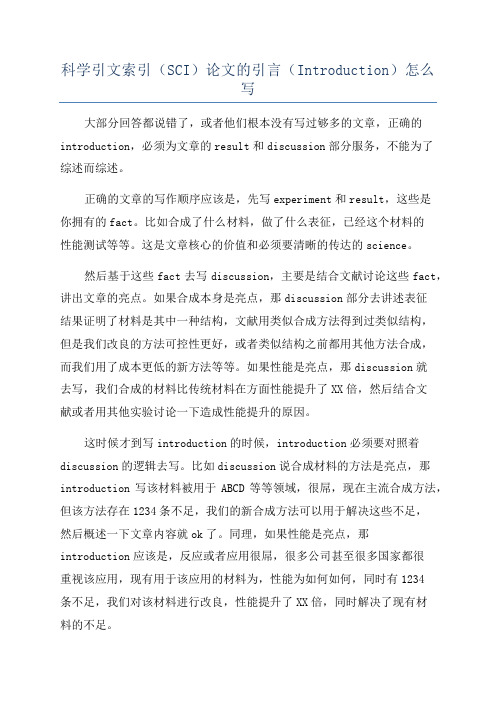
科学引文索引(SCI)论文的引言(Introduction)怎么写大部分回答都说错了,或者他们根本没有写过够多的文章,正确的introduction,必须为文章的result和discussion部分服务,不能为了综述而综述。
正确的文章的写作顺序应该是,先写experiment和result,这些是你拥有的fact。
比如合成了什么材料,做了什么表征,已经这个材料的性能测试等等。
这是文章核心的价值和必须要清晰的传达的science。
然后基于这些fact去写discussion,主要是结合文献讨论这些fact,讲出文章的亮点。
如果合成本身是亮点,那discussion部分去讲述表征结果证明了材料是其中一种结构,文献用类似合成方法得到过类似结构,但是我们改良的方法可控性更好,或者类似结构之前都用其他方法合成,而我们用了成本更低的新方法等等。
如果性能是亮点,那discussion就去写,我们合成的材料比传统材料在方面性能提升了XX倍,然后结合文献或者用其他实验讨论一下造成性能提升的原因。
这时候才到写introduction的时候,introduction必须要对照着discussion的逻辑去写。
比如discussion说合成材料的方法是亮点,那introduction写该材料被用于ABCD等等领域,很屌,现在主流合成方法,但该方法存在1234条不足,我们的新合成方法可以用于解决这些不足,然后概述一下文章内容就ok了。
同理,如果性能是亮点,那introduction应该是,反应或者应用很屌,很多公司甚至很多国家都很重视该应用,现有用于该应用的材料为,性能为如何如何,同时有1234条不足,我们对该材料进行改良,性能提升了XX倍,同时解决了现有材料的不足。
如果不这么写,只是把introduction当做泛泛的短review,文章很容易逻辑很别扭,经常会出现introduction说方法存在问题,然后文章内容是应用该方法去做研究,而不去解决问题。
英文科技论文写作方法
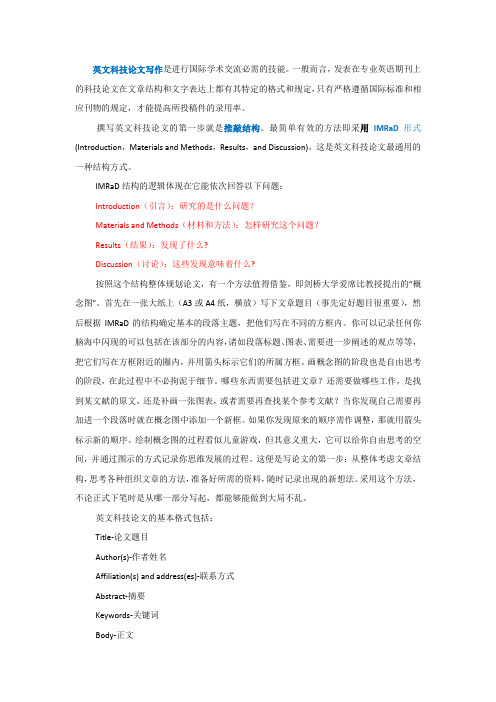
英文科技论文写作是进行国际学术交流必需的技能。
一般而言,发表在专业英语期刊上的科技论文在文章结构和文字表达上都有其特定的格式和规定,只有严格遵循国际标准和相应刊物的规定,才能提高所投稿件的录用率。
撰写英文科技论文的第一步就是推敲结构。
最简单有效的方法即采用IMRaD形式(Introduction,Materials and Methods,Results,and Discussion),这是英文科技论文最通用的一种结构方式。
IMRaD结构的逻辑体现在它能依次回答以下问题:Introduction(引言):研究的是什么问题?Materials and Methods(材料和方法):怎样研究这个问题?Results(结果):发现了什么?Discussion(讨论):这些发现意味着什么?按照这个结构整体规划论文,有一个方法值得借鉴,即剑桥大学爱席比教授提出的“概念图”。
首先在一张大纸上(A3或A4纸,横放)写下文章题目(事先定好题目很重要),然后根据IMRaD的结构确定基本的段落主题,把他们写在不同的方框内。
你可以记录任何你脑海中闪现的可以包括在该部分的内容,诸如段落标题、图表、需要进一步阐述的观点等等,把它们写在方框附近的圈内,并用箭头标示它们的所属方框。
画概念图的阶段也是自由思考的阶段,在此过程中不必拘泥于细节。
哪些东西需要包括进文章?还需要做哪些工作,是找到某文献的原文,还是补画一张图表,或者需要再查找某个参考文献?当你发现自己需要再加进一个段落时就在概念图中添加一个新框。
如果你发现原来的顺序需作调整,那就用箭头标示新的顺序。
绘制概念图的过程看似儿童游戏,但其意义重大,它可以给你自由思考的空间,并通过图示的方式记录你思维发展的过程。
这便是写论文的第一步:从整体考虑文章结构,思考各种组织文章的方法,准备好所需的资料,随时记录出现的新想法。
采用这个方法,不论正式下笔时是从哪一部分写起,都能够能做到大局不乱。
科技英语写作(5)—Introduction
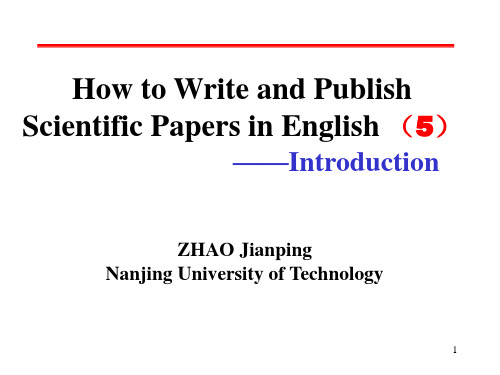
引言 有人说引言是最难写的。几乎所有的科技论文都 有引言部分,只是有的论文有专门的一节,有的 论文(比如通讯,快报等)仅仅是论文的第一段。 引言包含四个元素,或者说四个组成部分。 1,研究领域。 ,研究领域。 是与本研究工作的有关的背景介绍。正确地估计 研究课题的意义。应用背景。 也就是为什么要做这项工作。例如在基础研究方 面有何新意,有何应用前景。课题的意义估计不 足,说明作者的知识水平不高,估计过分则显得 不够严谨。
5
Introduction:写作内容
(4)解释或定义专门术语或缩写词 以帮助编辑、 )解释或定义专门术语或缩写词, 以帮助编辑、 审稿人和读者阅读与理解; 审稿人和读者阅读与理解; (5)叙述前人工作的欠缺以强调自己研究的创新时, )叙述前人工作的欠缺以强调自己研究的创新时 应慎重且留有余地, 应慎重且留有余地,可以采用类似于以下的表达 ——To the author’s knowledge… ; There is little information available in literature about…;等等 (6)适当地使用“I”,“We”或“Our”, “This )适当地使用“ , 或 paper”等词 以明确地指示作者本人的工作 如最好 等词, 等词 以明确地指示作者本人的工作; 使用 we conducted this study to determine whether …;
THANKS!
11
4
Introduction:写作内容 (2)在背景介绍和问题提出中,应引用“最相关” )在背景介绍和问题提出中,应引用“最相关” 的文献以指引读者.优先选择引用的文献包括相关 的文献以指引读者 优先选择引用的文献包括相关 研究中的经典、重要和最具说服力的文献, 研究中的经典、重要和最具说服力的文献, 力戒 刻意回避引用最重要的相关文献(甚至是对作者研 刻意回避引用最重要的相关文献 甚至是对作者研 究具有某种“启示”性意义的文献); 究具有某种“启示”性意义的文献 ;避免不恰当 地大量引用作者本人的文献; 地大量引用作者本人的文献; (3)采取适当的方式强调作者在本次研究中最重 ) 要的发现或贡献, 要的发现或贡献 , 让读者顺序逻辑的演进阅读论 文。
SCI科技论文Introduction四步法写作技巧
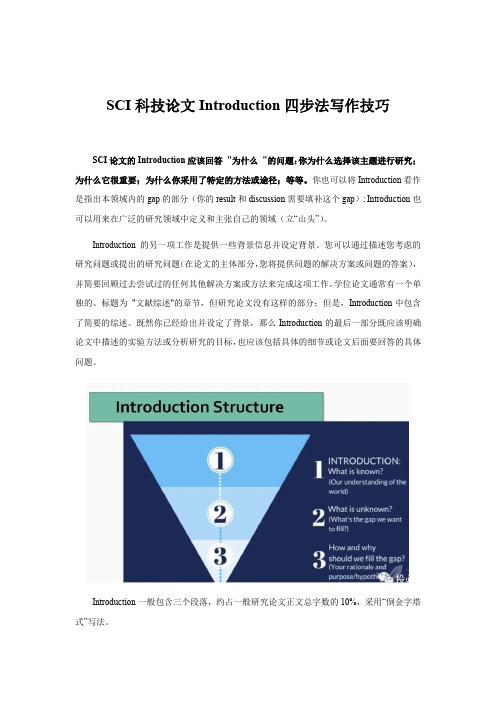
SCI科技论文Introduction四步法写作技巧SCI论文的Introduction应该回答"为什么"的问题:你为什么选择该主题进行研究;为什么它很重要;为什么你采用了特定的方法或途径;等等。
你也可以将Introduction看作是指出本领域内的gap的部分(你的result和discussion需要填补这个gap); Introduction也可以用来在广泛的研究领域中定义和主张自己的领域(立“山头”)。
Introduction的另一项工作是提供一些背景信息并设定背景。
您可以通过描述您考虑的研究问题或提出的研究问题(在论文的主体部分,您将提供问题的解决方案或问题的答案),并简要回顾过去尝试过的任何其他解决方案或方法来完成这项工作。
学位论文通常有一个单独的、标题为"文献综述"的章节,但研究论文没有这样的部分;但是,Introduction中包含了简要的综述。
既然你已经给出并设定了背景,那么Introduction的最后一部分既应该明确论文中描述的实验方法或分析研究的目标,也应该包括具体的细节或论文后面要回答的具体问题。
Introduction一般包含三个段落,约占一般研究论文正文总字数的10%,采用“倒金字塔式”写法。
四步法写Introduction1. 提供背景资料,设置背景Introduction的这一初始部分为读者准备了后面更详细、更具体的信息。
前几句一般都是概括性的。
以下是一些例子:一篇关于土壤中有机物的论文可以这样开头:"可持续的作物生产是土壤的物理、化学和生物特性的函数,而这些特性又明显地受到土壤中有机物的影响。
”一篇讨论细菌在治疗癌症方面可能发挥的有益作用的论文,可以这样开头。
"细菌作为抗癌剂的作用早在一百年前就被认识到了。
”一篇关于锂电池的论文可以用以下句子来介绍研究内容:“锂离子电池的快速增长及其新的用途,如为电动汽车提供动力和为电网供应储存电能,这就要求有更可靠的方法来了解和预测电池的性能和寿命。
英语 引言

SCI论文的introduction写作注意事项introduction(前言、导言、绪言、序言)是正文的引子,相当于演说中的开场白。
国内刊物introduction部分一般不需另立标题。
introduction应当对正文起到提纲挈领和引导阅读兴趣的作用。
SCI论文的introduction写作注意事项如下:introduction写作要点与时态运用(1)在叙述有关现象或普遍事实时,句子的主要动词多使用一般现在时。
如:“little is known about X”或“little literature is available on X”。
(2)在描述特定研究领域中最近的某种趋势,或者强调表示某些“最近”发生的事件对现在的影响时,常采用现在完成时。
如:“few studies have been done on X”或“little attention has been devoted to X”(3)在阐述作者本人研究目的的句子中应使用This paper, The experiment reported here 等词,以表示所涉及的内容是作者的工作,而不是指其他学者过去的研究。
SCI论文的introduction写作注意事项:①内容切忌空泛,篇幅不宜过长。
回顾历史择其要点'背景动态只要概括几句即可'引用参考文献不宜过多。
一般情况下,一篇3000~5000字的论文introduction字数在150~250字较合适。
②不必强调过去的工作成就。
回顾作者以往的工作只是为了交待此次写作的基础和动机,而不是写总结。
评价论文的价值要恰如其分,实事求是,慎用“首创”、“首次发现”、“达到国际一流水平”、“填补了国内空白”等提法。
因为首创必须有确切的资料。
对此,可以用相对较谨慎的说法表达,如“就所查文献,未见报道”等。
③切勿重复教科书或众所周知的内容。
如在讨论维生素D是否能预防骨质疏松的文章中,没有必要再说明什么是维生素D,什么是骨质疏松。
科技论文写作整理系列(4)——Introduction
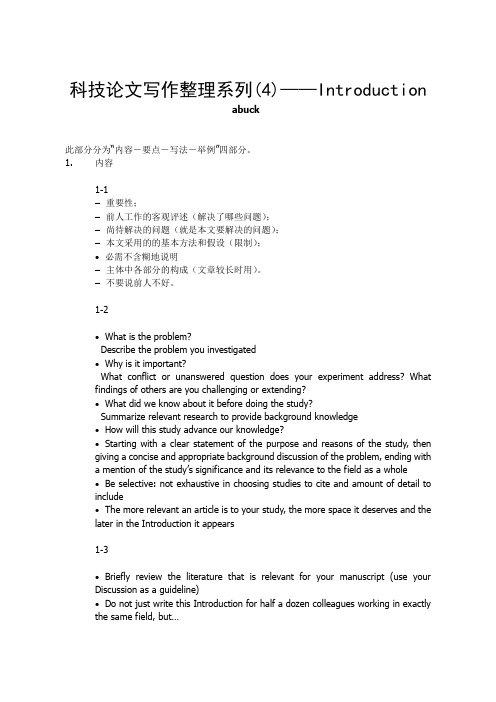
科技论文写作整理系列(4)——Introductionabuck此部分分为―内容-要点-写法-举例‖四部分。
1.内容1-1–重要性;–前人工作的客观评述(解决了哪些问题);–尚待解决的问题(就是本文要解决的问题);–本文采用的的基本方法和假设(限制);•必需不含糊地说明–主体中各部分的构成(文章较长时用)。
–不要说前人不好。
1-2• What is the problem?Describe the problem you investigated• Why is it important?What conflict or unanswered question does your experiment address? What findings of others are you challenging or extending?• What did we know about it before doing the study?Summarize relevant research to provide background knowledge• How will this study advance our knowledge?• Starting with a clear statement of the purpose and reasons of the study, then giving a concise and appropriate background discussion of the problem, ending witha mention of the study’s signifi cance and its relevance to the field as a whole• Be selective: not exhaustive in choosing studies to cite and amount of detail to include• The more relevant an article is to your study, the more space it deserves and the later in the Introduction it appears1-3• Briefly review the literature that is relevant for your manuscript (use your Discussion as a guideline)• Do not just write this Introduction for half a dozen colleagues working in exactly the same field, but…• write for a range of interested scientists• Finish with the aims of your work and present a clear hypothesis• Briefly review the literature• Address a wider audience than those working in exactly the same field• Give the aims of your research and a good hypothesis• A goo d hypothesis is one that can be tested, but it does not need to be ―correct‖• Explain why you did your research• The fact that nobody has done it before is not a good reason• Your study may follow logically from previous work• Your project may have been inspired by a practical problem1-4工作目的对工作目的的评价:该工作为什么很重要?工作背景:谁做了什么工作?做得怎么样?以前我们做了哪些工作?导读:读者应该注意该文章的哪些方面?有意义的要点有哪些?结论:读者期望什么样的结论呢?在提纲的前几个版本中,你应该包括实验过程中涉及到的所有内容(在这一点上,就像是段落的副标题)1-5引言在内容上应包括:为什么要进行这项研究?立题的理论或实践依据是什么?拟创新点何在?理论与(或)实践意义是什么?告诉读者你为什么要进行这项研究是引言的主要内容和目的,这其中也包括说明这项研究的理论和(或)实践意义。
Introduction的写作套路,你都Get到了吗?
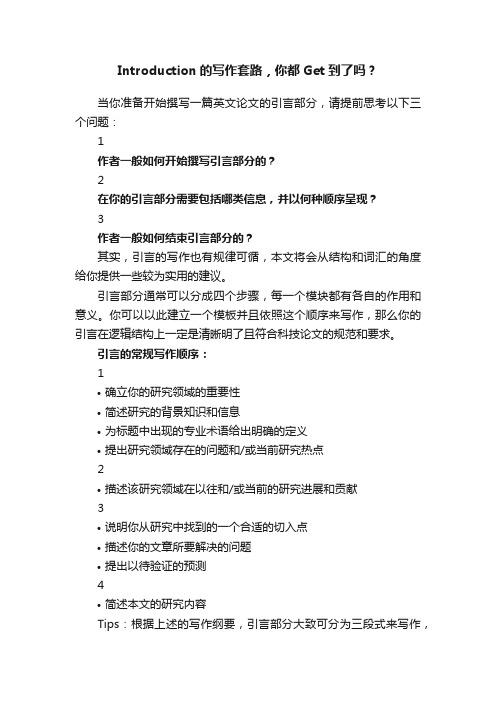
Introduction的写作套路,你都Get到了吗?当你准备开始撰写一篇英文论文的引言部分,请提前思考以下三个问题:1作者一般如何开始撰写引言部分的?2在你的引言部分需要包括哪类信息,并以何种顺序呈现?3作者一般如何结束引言部分的?其实,引言的写作也有规律可循,本文将会从结构和词汇的角度给你提供一些较为实用的建议。
引言部分通常可以分成四个步骤,每一个模块都有各自的作用和意义。
你可以以此建立一个模板并且依照这个顺序来写作,那么你的引言在逻辑结构上一定是清晰明了且符合科技论文的规范和要求。
引言的常规写作顺序:1•确立你的研究领域的重要性•简述研究的背景知识和信息•为标题中出现的专业术语给出明确的定义•提出研究领域存在的问题和/或当前研究热点2•描述该研究领域在以往和/或当前的研究进展和贡献3•说明你从研究中找到的一个合适的切入点•描述你的文章所要解决的问题•提出以待验证的预测4•简述本文的研究内容Tips:根据上述的写作纲要,引言部分大致可分为三段式来写作,其中2,3两部分可以合并到一个段落。
仅仅指出引言部分的写作顺序和写作内容可能还是会有些抽象。
接下去会讨论一些写作示例,帮助科研作者们更好地理解这种流程化引言写作的方式。
首先看一段比较简单的引言(10 sentences),但写作结构很完整,你可以来试着逐句分析一下作者在每个句子里想表达的内容。
The synthesis of flexible polymer blends from polylactide and rubberIntroduction1 Polylactide (PLA) has received much attention in recent years due to its biodegradable properties, which offer important economic benefits.2 PLA is a polymer obtained from corn and is produced by the polymerisation of lactide.3 It has many possible uses in the biomedical field1 and has also been investigated as a potential engineering material.2,34 However, it has been found to be too weak under impact to be used commercially.4 1阐明研究主题的重要性2提供一般背景信息3补充一些细节/特点4描述该领域存在的问题或当前研究焦点5 One way to toughen polymers is to incorporate a layer of rubber particles5and there has been extensive research regarding the rubber modification of PLA.6 For example, Penney et al. showed that PLA composites could be prepared using blending techniques6 and more recently, Hillier established the toughness of such composites.77 However, although the effect of the rubber particles on the mechanical properties of copolymer systems was demonstrated over two years ago,8 little attention has been paid to the selection of an appropriate rubber component.5从提出问题过渡到文献综述6综述该领域的主要研究项目7指出本研究的切入点/创新点8 The present paper presents a set of criteria for selecting such a component. 9 On the basis of these criteria it then describes the preparation of a set of polymer blends using PLA and a hydro-carbon rubber(PI). 10 This combination of two mechanistically distinct polymerisations formed a novel copolymer in which the incorporation of PI significantly increased flexibility.8概括本论文的研究内容9简述研究方法10声明研究结果对于每个部分,下面分别展示了一些更通用的句型、短语或词汇示例,你也可以把它们当做引言部分的写作模板,套用到自己的稿件中。
怎么写论文的Introduction部分
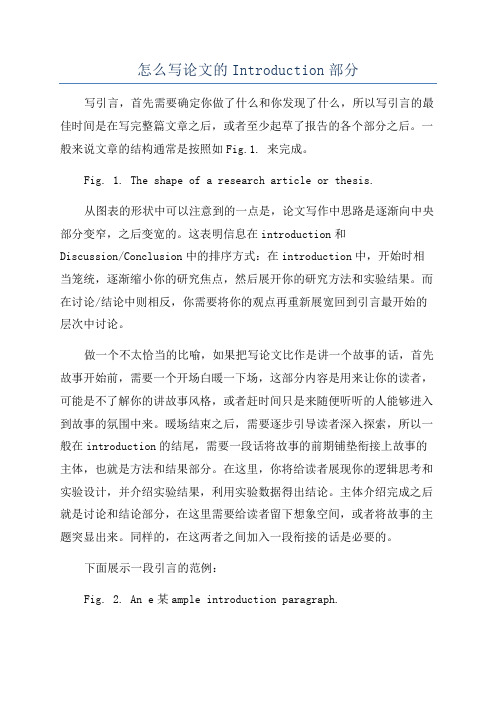
怎么写论文的Introduction部分
写引言,首先需要确定你做了什么和你发现了什么,所以写引言的最佳时间是在写完整篇文章之后,或者至少起草了报告的各个部分之后。
一般来说文章的结构通常是按照如Fig.1. 来完成。
Fig. 1. The shape of a research article or thesis.
从图表的形状中可以注意到的一点是,论文写作中思路是逐渐向中央部分变窄,之后变宽的。
这表明信息在introduction和
Discussion/Conclusion中的排序方式:在introduction中,开始时相当笼统,逐渐缩小你的研究焦点,然后展开你的研究方法和实验结果。
而在讨论/结论中则相反,你需要将你的观点再重新展宽回到引言最开始的层次中讨论。
做一个不太恰当的比喻,如果把写论文比作是讲一个故事的话,首先故事开始前,需要一个开场白暖一下场,这部分内容是用来让你的读者,可能是不了解你的讲故事风格,或者赶时间只是来随便听听的人能够进入到故事的氛围中来。
暖场结束之后,需要逐步引导读者深入探索,所以一般在introduction的结尾,需要一段话将故事的前期铺垫衔接上故事的主体,也就是方法和结果部分。
在这里,你将给读者展现你的逻辑思考和实验设计,并介绍实验结果,利用实验数据得出结论。
主体介绍完成之后就是讨论和结论部分,在这里需要给读者留下想象空间,或者将故事的主题突显出来。
同样的,在这两者之间加入一段衔接的话是必要的。
下面展示一段引言的范例:
Fig. 2. An e某ample introduction paragraph.。
如何轻松漂亮的写出Introduction
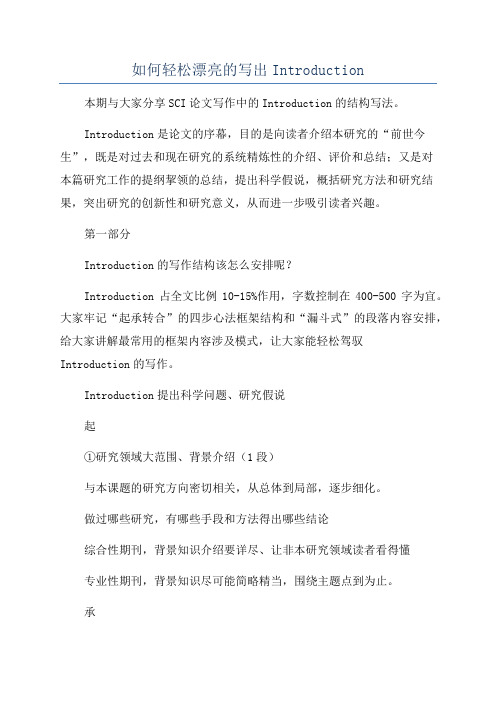
如何轻松漂亮的写出Introduction本期与大家分享SCI论文写作中的Introduction的结构写法。
Introduction是论文的序幕,目的是向读者介绍本研究的“前世今生”,既是对过去和现在研究的系统精炼性的介绍、评价和总结;又是对本篇研究工作的提纲挈领的总结,提出科学假说,概括研究方法和研究结果,突出研究的创新性和研究意义,从而进一步吸引读者兴趣。
第一部分Introduction的写作结构该怎么安排呢?Introduction占全文比例10-15%作用,字数控制在400-500字为宜。
大家牢记“起承转合”的四步心法框架结构和“漏斗式”的段落内容安排,给大家讲解最常用的框架内容涉及模式,让大家能轻松驾驭Introduction的写作。
Introduction提出科学问题、研究假说起①研究领域大范围、背景介绍(1段)与本课题的研究方向密切相关,从总体到局部,逐步细化。
做过哪些研究,有哪些手段和方法得出哪些结论综合性期刊,背景知识介绍要详尽、让非本研究领域读者看得懂专业性期刊,背景知识尽可能简略精当,围绕主题点到为止。
承②研究领域细化及未知空白的领域介绍具体一些研究点的研究现状,以及本研究聚焦点的重要性、必要性、迫切性、当下研究的局限性。
研究空白分:当前研究的不足、研究正确性的质疑与验证、当前研究的补充入手点:其一,技术、数据库、实验方案需要创新或者改良;其二,物质、功能、机制、现象有待进一步探索和发现。
转③提出科学问题以及本文的科学假说、目的(1段)本文的研究目的和重要性,有针对性地对研究空白提出解决方案。
④研究方法和结果(1段)用技术、方法、实验发现结果合⑤本研究的结论和意义(1段)结论:对本文的实验结果一句话进行总结。
意义入手点:理论创新、实践应用、规律理解、社会发展、环境保护、资源节约、省时省力等等。
第二部分1研究领域大范围、背景介绍2研究领域细化及未知空白的领域介绍3提出科学问题以及本文的科学假说、目的4研究方法和结果5本研究的结论和意义第三部分Introduction的写作小Tips。
introduction写作方法及技巧
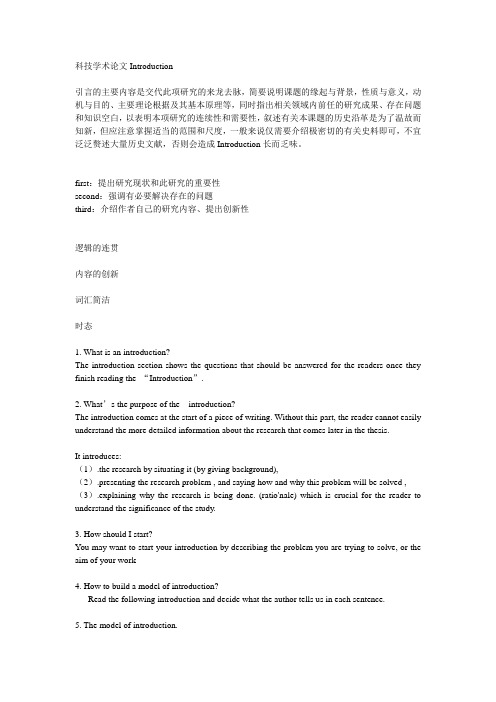
科技学术论文Introduction引言的主要内容是交代此项研究的来龙去脉,简要说明课题的缘起与背景,性质与意义,动机与目的、主要理论根据及其基本原理等,同时指出相关领域内前任的研究成果、存在问题和知识空白,以表明本项研究的连续性和需要性,叙述有关本课题的历史沿革是为了温故而知新,但应注意掌握适当的范围和尺度,一般来说仅需要介绍极密切的有关史料即可,不宜泛泛赘述大量历史文献,否则会造成Introduction长而乏味。
first:提出研究现状和此研究的重要性second:强调有必要解决存在的问题third:介绍作者自己的研究内容、提出创新性逻辑的连贯内容的创新词汇简洁时态1. What is an introduction?The introduction section shows the questions that should be answered for the readers once they finish reading the “Introduction”.2. What’s the purpose of the introduction?The introduction comes at the start of a piece of writing. Without this part, the reader cannot easily understand the more detailed information about the research that comes later in the thesis.It introduces:(1).the research by situating it (by giving background),(2).presenting the research problem , and saying how and why this problem will be solved , (3).explaining why the research is being done. (ratio'nale) which is crucial for the reader to understand the significance of the study.3. How should I start?You may want to start your introduction by describing the problem you are trying to solve, or the aim of your work4. How to build a model of introduction?Read the following introduction and decide what the author tells us in each sentence.5. The model of introduction.(1) establishes the importance of this research topic确立研究主题的重要性(2) provides general background information for the reader.为读者提供总体的背景信息(3) in a more specific/detailed way, using research references to support both the background facts and the claim for significance.与第1、2句的做法一样,但是更具体(4) describes the general problem area or the current research focus of the field.描述了所研究领域的一般性问题或当前的研究焦点(5) provides a transition between the general problem area and the literature review提供了总体问题领域到文献综述之间的一个过渡(6) provides a brief overview of key research projects in this area.概述了此研究领域重要的研究项目(7) describes a gap in the research描述了已有研究的空白(8) describes the paper itself描述了论文本身的工作(9) gives details about the methodology详细描述了论文中所用的方法(10) announces the findings公布了论文的结论6. Four components of a model.(1)Establish the importance of your fieldProvide background/ facts/information (possibly from research)Define the terminology in the title/key wordsPresent the problem area/current research focus确立研究领域的重要性提供背景事实或信息(有可能来自现有文献)定义题目或关键词中的术语给出所研究问题的范畴或目前的研究重点(2)Previous and/or current research and contributions前期的研究或目前的研究及其贡献(3)Locate a gap in the researchDescribe the problem you will addressPresent a prediction to be tested确定已有研究工作的空白;描述你要解决的问题呈现要验证的预测(4)Describe the present paper描述现在的论文7.Grammar and writing skills.语法时态写作技巧8. V ocabulary词汇的简洁举例三篇文章:1.Gene expression profiling and pathway analysis of hepatotoxicity induced by triptolide in Wistar rats在Wistar大鼠中,通过基因表达谱和通路分析由雷公藤甲素诱导的肝毒性引言的主要内容是交代此项研究的来龙去脉,例如本文中,简要说明课题的缘起与背景,TP的性质Triptolide (diterpenoid triepoxide, TP), purified from the shrublike vine Tripterygium wilfondii Hook F (TWHF)与药理学意义possesses anti-inflammatory, anti-fertility, anti-neoplastic and immunosuppressive activities 实验的动机However, clinical use of TWHF or TP has been limited due to severe adverse reactions, such as gastrointestinal upset, diarrhea, reproductive toxicity and problems associated with circulatory systems目的we hypothesized that liver is a major toxic target of TP treatment. Thus, it is essential to elucidate the mechanism of TP-induced hepatotoxicity from a safety point of view.the aim of our study was to identify candidate genes associated with TP treatment and to provide novel insights to better elucidate the mechanisms of toxic effects of TP.主要理论根据及其基本原理Considering that microarray technology is recognized as a reliable toxicologica method to determine mechanisms of drug-induced toxicity, identify biomarkers and to predict chemical toxicity.Therefore, the aim of our study was to identify candidate genes associated with TP treatment and to provide novel insights to better elucidate the mechanisms of toxic effects of TP.同时指出相关领域内前任的研究成果possesses anti-inflammatory, anti-fertility, anti-neoplastic and immunosuppressive activities (Chen, 2001; Huynh et al., 2000; Panichakul et al., 2006).have emerged as treatments of rheumatoid arthritis, systemic lupus erythematosus, nephritis, leprosy and asthma (Lipsky and Tao, 1997; Liu et al., 2005; Zhang et al., 2010).clinical use of TWHF or TP has been limited due to severe adverse reactions, such as gastrointestinal upset, diarrhea, reproductive toxicity and problems associated with circulatory systems (Hikim et al., 2000; Ni et al., 2008; Yang et al., 2012; Zhang et al., 2011).Recently, hepatotoxicity induced by various extracts of TWHF in animals and humans has been reported by many researches (He et al., 2006; Mei et al., 2005; Wang et al., 2007) To date, only mitochondrial respiratory chain inhibition, lipid peroxidation, DNA damage and hepatocyte apoptosis were proposed to be involved in TP-induced liver injury (Fu et al., 2011; Mei et al., 2005; Yao et al., 2008).等存在问题和知识空白Hepatic differential gene expression was analyzed using oligonucleotide microarray analysis for over-represented functions and phenotypically anchored to complementary histopathologic, biochemical, and dosimetry data in the liver. The results indicate that TP affects diverse cellular pathways, including insulin signaling pathway, glucose metabolism, cell cycling, oxidative stress and apoptosis. These data provide a clearer understanding of the molecular mechanisms of TP-induced hepatotoxicity, as well as useful information for predicting drug hepatotoxicity.以表明本项研究的连续性和需要性,叙述有关本课题的历史沿革是为了温故而知新,Triptolide (diterpenoid triepoxide, TP), purified from the shrublike vine Tripterygium wilfondii Hook F (TWHF), possesses anti-inflammatory, anti-fertility, anti-neoplastic and immunosuppressive activities (Chen, 2001; Huynh et al., 2000; Panichakul et al., 2006). Recently, the methanol/chloroform (T2) and ethyl acetate (EA) extracts of TWHF, in which TP was identified as the principal active compound, have emerged as treatments of rheumatoid arthritis, systemic lupus erythematosus, nephritis, leprosy and asthma (Lipsky and Tao, 1997; Liu et al., 2005; Zhang et al., 2010). However, clinical use of TWHF or TP has been limited due to severe adverse reactions, such as gastrointestinal upset, diarrhea, reproductive toxicity and problems associated with circulatory systems (Hikim et al., 2000; Ni et al., 2008; Yang et al., 2012; Zhang et al., 2011).Recently, hepatotoxicity induced by various extracts of TWHF in animals and humans has been reported by many researches (He et al., 2006; Mei et al., 2005; Wang et al., 2007). Besides, Liu et al., (2010) found that potential hepatotoxicity in rats treated with TP for 28 days was associated with increasing levels of serum alanine aminotransferase (ALT) and aspartate aminotransferase (AST) (Liu et al., 2010). Moreover, it was reported that oral administration of TP to rats could lead to liver injury or even death (Fu et al., 2011). In addition to this, our previous investigation showed that the concentration of TP found in liver exceeds those observed in other tissues, such as spleen, lung, heart, and kidney (unpublished data). On account of this, we hypothesized that liver is a major toxic target of TP treatment. Thus, it is essential to elucidate the mechanism of TP-induced hepatotoxicity from a safety point of view.Unfortunately, its underling mechanisms are still insufficiently recognized. To date, only mitochondrial respiratory chain inhibition, lipid peroxidation, DNA damage and hepatocyte apoptosis were proposed to be involved in TP-induced liver injury (Fu et al., 2011; Mei et al.,2005; Yao et al., 2008). Considering that microarray technology is recognized as a reliable toxicologica method to determine mechanisms of drug-induced toxicity, identify biomarkers and to predict chemical toxicity (Lee et al., 2010; Wang et al., 2011). Therefore, the aim of our study was to identify candidate genes associated with TP treatment and to provide novel insights to better elucidate the mechanisms of toxic effects of TP.Here, we describe genome-wide gene expression in the TP-exposed Wistar female rat liver. Differential gene expression was evaluated in 6-week-old female Wistar rat livers following 14 days of continuous exposure to large doses of TP. Hepatic differential gene expression was analyzed using oligonucleotide microarray analysis for over-represented functions and phenotypically anchored to complementary histopathologic, biochemical, and dosimetry data in the liver. The results indicate that TP affects diverse cellular pathways, including insulin signaling pathway, glucose metabolism, cell cycling, oxidative stress and apoptosis. These data provide a clearer understanding of the molecular mechanisms of TP-induced hepatotoxicity, as well as useful information for predicting drug hepatotoxicity.2.综述Blood vessels, a potential therapeutic target in rheumatoid arthritis?血管,类风湿性关节炎潜在的治疗靶标?IntroductionRheumatoid arthritis (RA) can be defined as a disease of the blood vessels, both micro- and macro-vessels. The formation of new micro-vessels is in fact necessary to afford the nutritional supply to proliferating synovial pannus, while macro-vessels are the site where accelerated atherosclerosis driven by disease’s systemic inflammation develops. New vessels formation on one side, and atherosclerotic plaque progression on the other, might seem two different biological phenomena, the first related to the articular involvement of the disease, the second to its main systemic complication. In this context, targeting blood vessels in RA might mean either attempting to reduce synovial vascular supply starving the synovial pannus limiting its proliferation or, in the other case, trying to limit macro-vessels’damage outside the joint. In this review we will analyse the possibility of targeting synovial microvessels to treat rheumatoid arthritis, but we will discuss as well the evidence supporting a link between micro- and macro-vascular involvements in RA.综述的介绍,介绍所提到物质的基本概念,简要说明课题的缘起与背景,RA与血管生成相关,与血管生成的必要性,在这里,说明该文章立题的主要依据与主要原理,并提出在此综述中接下来会说到的内容,如:作者将分析滑膜微血管治疗类风湿关节炎的可能性,且讨论,血管与RA微观和宏观之间联系的证据。
英文论文引言的写作技巧(一)
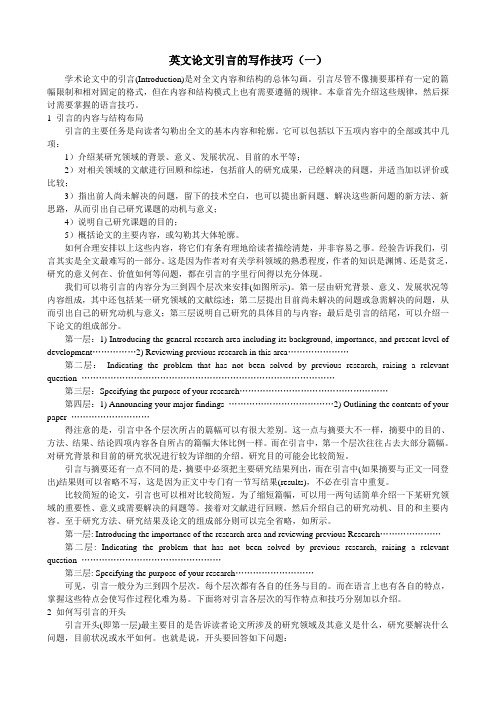
英文论文引言的写作技巧(一)学术论文中的引言(Introduction)是对全文内容和结构的总体勾画。
引言尽管不像摘要那样有一定的篇幅限制和相对固定的格式,但在内容和结构模式上也有需要遵循的规律。
本章首先介绍这些规律,然后探讨需要掌握的语言技巧。
1 引言的内容与结构布局引言的主要任务是向读者勾勒出全文的基本内容和轮廓。
它可以包括以下五项内容中的全部或其中几项:1)介绍某研究领域的背景、意义、发展状况、目前的水平等;2)对相关领域的文献进行回顾和综述,包括前人的研究成果,已经解决的问题,并适当加以评价或比较;3)指出前人尚未解决的问题,留下的技术空白,也可以提出新问题、解决这些新问题的新方法、新思路,从而引出自己研究课题的动机与意义;4)说明自己研究课题的目的;5)概括论文的主要内容,或勾勒其大体轮廓。
如何合理安排以上这些内容,将它们有条有理地给读者描绘清楚,并非容易之事。
经验告诉我们,引言其实是全文最难写的—部分。
这是因为作者对有关学科领域的熟悉程度,作者的知识是渊博、还是贫乏,研究的意义何在、价值如何等问题,都在引言的字里行间得以充分体现。
我们可以将引言的内容分为三到四个层次来安排(如图所示)。
第一层由研究背景、意义、发展状况等内容组成,其中还包括某一研究领域的文献综述;第二层提出目前尚未解决的问题或急需解决的问题,从而引出自己的研究动机与意义;第三层说明自己研究的具体目的与内容;最后是引言的结尾,可以介绍一下论文的组成部分。
第一层:1) Introducing the general research area including its background, importance, and present level of development……………2) Reviewing previous research in this area…………………第二层:Indicating the problem that has not been solved by previous research, raising a relevant question ……………………………………………………………………………第三层:Specifying the purpose of your research……………………………………………第四层:1) Announcing your major findings ………………………………2) Outlining the contents of your paper ………………………得注意的是,引言中各个层次所占的篇幅可以有很大差别。
- 1、下载文档前请自行甄别文档内容的完整性,平台不提供额外的编辑、内容补充、找答案等附加服务。
- 2、"仅部分预览"的文档,不可在线预览部分如存在完整性等问题,可反馈申请退款(可完整预览的文档不适用该条件!)。
- 3、如文档侵犯您的权益,请联系客服反馈,我们会尽快为您处理(人工客服工作时间:9:00-18:30)。
(三)圈定自己的研究范围
前言的另外一个作用就是告诉读者,包括(reviewer), 你的文章主要研究内容。如果处理不好,reviewer会提出严 厉的建议,比如你没有考虑某种可能性,某种研究手段等等。
为了减少这种争论,在前言的结尾你就要明确提出本文研究
的范围:
(1)时间尺度问题 如果你的问题涉及比较长的时序,你可以明确地提出
英文科技论文写作的语言技巧 (INTRODUCTION)
(一)指出当前研究的不足 (二)提出自己的观点 (三)圈定自己的研究范围
(四)最后的圆场
(五)怎样提出观点
(一)指出当前研究的不足
——为了说明自己的研究的重要性
However, little information.. little attention... little work... little data little research or few studies few investigations... few researchers... few attempts... or no none of these studies
as a result,
表明递进关系,可用furthermore, further, moreover, in addition,
当写完一段英文,最好首先检查一下是否较好地应用了
这些连接词。
(2) 段落的整体逻辑 经常我们要叙述一个问题的几个方面。这种情况下,一 定要注意逻辑结构。首先第一段要明确告诉读者你要讨论几 个部份: ...Therefore, there are three aspects of this problem have to be addressed. The first question involves... The second problem relates to The third aspect deals with... 上面的例子可以清晰地把观点逐层叙述。Or, 可以直接 用First, Second, Third...Finally,..当然,Furthermore, in addition等可以用来补充说明。
(五)怎样提出观点
在提出自己的观点时,采取适当的策略很重要。不合适 的句子通常会遭到reviewer的置疑。 (1)如果观点不是这篇文章最新提出的,通常要用
We confirm that...
(2)对于自己很自信的观点,可用
We believe that...
(3)在更通常的情况下,由数据推断出一定的结论,用: Results indicate, infer, suggest, imply that...
尺度比较新的问题研究不足;
(2) 研究手段问题
如果你要应用一种新手段或者研究方向,你可以提出当 前比较流行的方法以及物质性质,然后说对你所研究的方向 和方法,研究甚少;
(3) 研究区域问题
首先总结相邻区域或者其它区域的研究,然后强调这
一区域研究不足;
(4) 不确定性
虽然前人对这一问题研究很多,但是目前有两种或者
本文只关心这一时间范围的问题。
We preliminarily focus on the older (younger)... 或者有两种时间尺度的问题 (long-term and short
term),你可以说两者都重要,但是本文只涉及其中一种。
(2) 研究区域的问题 和时间问题一样,明确提出你只关心这一地区。
resulted from..
Or This is probably a consequence of It seems that .. can account for (interpret) this.. Or It is possible that it stem from...
注意:
这些结构要合理搭配。如果通篇是类型(1)和(5),那
(4) 在极其特别的情况才可以用:
We put forward (discover, observe..) .. "for the first time"
来强调自己的创新。 (5) 如果自己对所提出的观点不完全肯定,可用: We tentatively put forward (interpret this to..) Or The results may be due to (caused by) attributed to
更多种的观点,这种uncertainty, ambiguity,值得进一
步澄清;
(5) 提出自己的假设来验证
如果自己的研究完全是新的,没有前人的工作进行
对比,在这种情况下,你可以自信地说,根据提出的过
程,存在这种可能的结果,本文就是要证实这种结果。
We aim to test the feasibility (reliability) of the ... It is hoped that the question will be resolved (fall away) with our proposed method (approach).
这篇文章的意义就大打折扣。如果全是(2),肯定会遭到
置疑。所以要仔细分析自己成果的创新性以及可信度。
(六)连接词与逻辑
写英文论文最常见的一个毛病就是文章的逻辑不清楚。 解决的方法有: (1)句子上下要连贯,不能让句子之间独立,常见的连接 词有: However, also, in addition, Consequently, afterwards, moreover, Furthermore, Further, although, unlike, in contrast, Similarly, Unfortunately, alternatively, parallel results, In order to, despite, For example, Compared with other results, thus, therefore...
(四)最后的圆场
在前言的最后,还可以总结性地提出,这一研究对其 它研究的帮助。或者说,
further studies on ... will be summarized in our next study
(or elsewhere) 总之,其目的就是让读者把思路集中到你要讨论的问 题上来。减少争论(arguments). 关于词汇以及常用结构,要经常总结,多读多模仿才 能融会贯通。
Further studies are still necessary... essential...
为了强调自己研究的重要性,一般还要在However 之前介绍自己研究问题的反方面,比如:
(1) 时间问题 如果你研究的问题时间上比较新,你就可以大量提及对
ห้องสมุดไป่ตู้
时间较老的问题的研究及重要性,然后说(However),对时间
has (have) been less done on ... focused on attempted to conducted investigated studied (with respect to)
Previous research ( studies, records) has (have) failed to consider ignored misinterpreted neglected to overestimated, underestimated mislead thus, these previous results are inconclusive, misleading, questionable, controversial.. Uncertainties (discrepancies) still exist ...
(二)提出自己的观点
We aim to This paper reports on provides results extends the method.. focus on The purpose of this paper is to Furthermore, Moreover, In addition, we will also discuss...
这种引导一般提出一种新方法,或者一种新方向
如果研究的方法以及方向和前人一样,可以通过下面的方式 强调自己研究工作的重要意义: However, data is still scarce rare less accurate there is still dearth of We need to provide more documents aim to data have to records studies increase the dataset
用好这些连接词,能够使观点表达得有层次,更加明确。比如,
如果叙述有时间顺序的事件或者文献,最早的文献可用: AA advocated it for the first time. 接下来:Then BB further demonstrated that. 再接下来:Afterwards, CC. 如果还有:More recent studies by DD.. 如果叙述两种观点,要把它们截然分开 AA put forward that...
In contrast, BB believe
or Unlike AA, BB suggest or On the contrary (表明前面的观点错误,如果只是表明两种对立的
观点,用in contrast),BB...
如果两种观点相近,可用: AA suggest…, Similarly, alternatively, BB.. Or Also, BB… or BB also does... 表示因果或者前后关系,可用Consequently, therefore,
